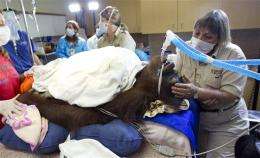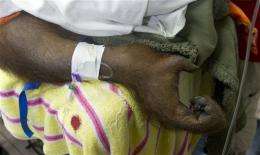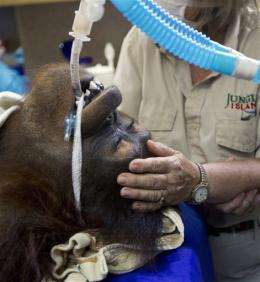Orangutan's cancer treatment similar to humans

(AP)—Peanut is an 8-year-old orangutan and a star attraction at Miami's Jungle Island. These days she's also got a team of cancer doctors huddling around her, watching as the chemo drip flows into her veins.
Peanut, who was diagnosed with non-Hogkin lymphoma, is not the first great ape to be treated for cancer like a human. An orangutan with advanced stage cancer at the National Zoo in Washington had surgery to remove a cancerous intestinal tumor in 2000. In 2009, two female gorillas at the North Carolina Zoo underwent radiation therapy. All three cases involved much older apes, in their 30s or 40s, and all had to be euthanized.
But while other animals are treated with chemotherapy, it's not common among orangutans.
Dr. Ryan DeVoe, senior veterinarian at the North Carolina Zoo where the two female gorillas lived, said he has found no record of other great apes being treated with chemo. But he also noted that many cases involving great apes with cancer are not reported or documented.
DeVoe said another unique aspect of Peanut's case is that, unlike the older apes, she has age on her side for either being cured or at least experiencing remission and living normally and comfortably for a long period of time.
The orangutan has been undergoing chemotherapy to treat the aggressive lymphoma since August.

Peanut's diagnosis came by chance when her veterinary team found she had an intestinal obstruction and further testing revealed the cancer. The private zoo had no board certified veterinary oncologist on staff and turned to the Sylvester Comprehensive Cancer Center at the University of Miami Miller School of Medicine. A team there, along with UM's Division of Comparative Pathology, which specializes in wildlife, confirmed the diagnosis and is now providing guidance for Peanut's treatment.
"I've never had the same combination of fear and enthusiasm in one patient before," said Dr. Joseph Rosenblatt, one of the doctors treating Peanut. "We don't know what to expect and yet we're intensely curious and potentially hopeful that we can help the animal."
Working on an orangutan is a first for Rosenblatt, who has never worked on an animal larger than a mouse.
"When the animal looks at you in the eye, it's both a sympathetic as well as a look that radiates intelligence," he said.
Peanut has a fraternal twin named Pumpkin, a rarity in the animal kingdom. They are the youngest of six orangutans at Jungle Island and a hit with park visitors. Both are highly intelligent and have been taught to use sign language and an iPad to communicate with their trainers, but they have distinct personalities. Peanut is welcoming and demanding, offering her doctor a twig in return for his water bottle. Pumpkin is quiet and her hair hangs low over her forehead. Pumpkin has not been diagnosed with the disease.
Rosenblatt said doctors chose a plan for treatment that has been most effective in humans, adding that they are treating Peanut's lymphoma with slightly reduced doses in an effort not to overshoot. The process that might take 4 to 5 hours in a human takes about 3 hours in Peanut, who will get six doses—21 days apart—unless her body can't handle it.

Peanut's doctors caution against raising expectations about her future and how effective the treatments will be.
"They work very well in human beings, but we don't know if they will work as well in this setting," Rosenblatt said.
Unlike humans, Peanut must be sedated for her treatments at an animal clinic in Miami. And although doctors know anesthesia causes nausea in animals, it is not clear if that or the chemo caused Peanut to vomit after her first treatment. She stays indoors out of sight of park visitors soon after the treatments and comes outside into an enclosure only when she feels up to it.
Her caretakers say explaining cancer to a human is difficult, but explaining it to a highly intelligent animal such as Peanut who communicates with her trainers and park visitors is nearly impossible.
"That is one part of cancer we do not have to deal with," said veterinarian Jason Chatfield, Jungle Island's general curator. "We made it a point not to even talk about the cancer in front of her because she may not comprehend cancer, disease, lymphoma and all these fancy words. She absolutely knows something is wrong, something is different with her." He said the team wants to keep a positive attitude around her.
Born in captivity, Peanut and Pumpkin came to the zoo when they were 6 months old.
"I have been with her since she was born," said Linda Jacobs, Peanut's trainer, holding back tears. "So I really am very sensitive to her needs and her moods."
Jacobs said Peanut is fatigued but hasn't lost much of her reddish-orange hair "and she still has that twinkle in her eye."
Despite possible complications and an uncertain outcome, Rosenblatt said Peanut is still a model patient "and God willing, she will be a cancer survivor."
Copyright 2012 The Associated Press. All rights reserved. This material may not be published, broadcast, rewritten or redistributed.


















